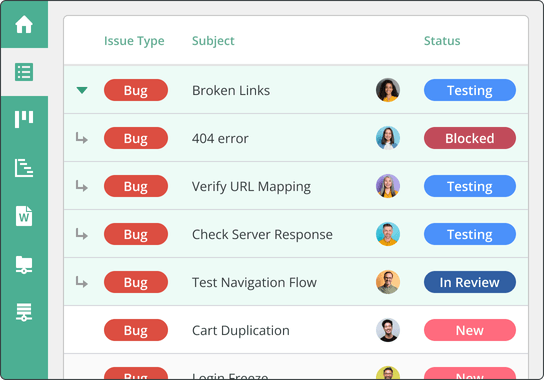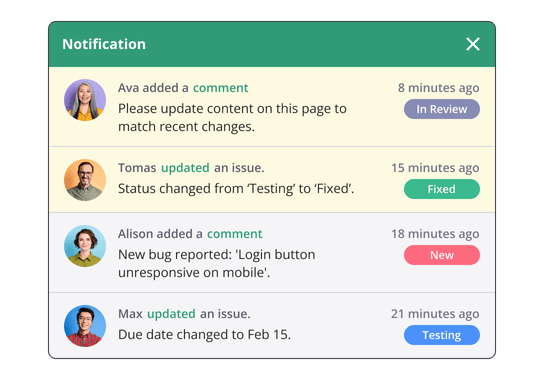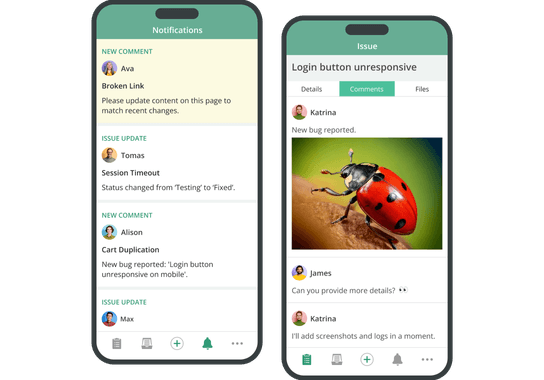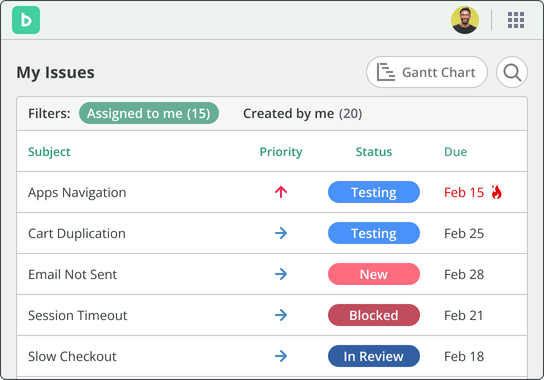issue & bug tracking
- Identifying bugs or defects in the system,
- Recording issue details in a centralized location,
- Managing and prioritizing based on severity and impact,
- Resolving bugs through team collaboration and verification,
- Enhancing functionality, performance, and user experience.
Overview of the bug tracking lifecycle
Bug identification. Users, testers, or developers find bugs during testing or in live environments. Once identified, the bug is recorded in the bug tracking tool with a detailed description, including steps to reproduce the issue and any relevant screenshots or logs.
Bug reporting. The bug is formally reported as a ticket or issue in the bug tracking system, which captures key details like its severity, environment, and expected vs. actual behavior.
Bug assignment. It is then assigned to a team member, typically a developer or engineer, with the necessary expertise to resolve it. The bug tracking tool helps ensure that the right person is notified and can start working on the issue based on its priority and complexity.
Bug prioritization. Not all bugs have the same impact, so they are prioritized based on severity, urgency, and how they affect the system or users.
Bug resolution. The assigned team member begins working on fixing the bug, often by replicating the issue and debugging the code. Once the issue is resolved, the fix is tested to ensure it works as expected and does not introduce new problems.
Testing and verification. After the bug is fixed, it is tested by quality assurance (QA) teams or automated testing tools to verify that the resolution is successful. If the fix works correctly, the bug is considered resolved; if not, it may be reopened for further work.
Bug closure. Once the fix is verified, the bug is marked as closed in the bug tracking system. Although the issue is officially resolved, it remains in the system for future reference and reporting.
Reporting and analysis. Bug tracking systems often include reporting features to help teams analyze the frequency, severity, and types of bugs over time. This data can be used to improve future development processes and prevent similar issues from arising.
Project and code management together.
Benefits of bug tracking software
1. Centralized bug reporting for clear visibility
2. Streamlined bug assignment for faster resolution
3. Full lifecycle tracking for comprehensive issue management
4. Real-time collaboration for quicker fixes
5. Seamless integration with development tools
6. Automated updates to keep your team informed
7. Detailed bug documentation for improved troubleshooting
8. Bug tracking integrates with project management tools
Your all-in-one bug tracking solution
Custom workflows for tailored bug management
Backlog’s custom statuses and issue templates tailor the bug tracking process to your team’s needs, ensuring every issue follows the right path from identification to resolution.
- Minimize delays
- Optimize workflows for maximum efficiency
- Streamline onboarding and product adoption

Real-time collaboration for faster resolution
Collaborate with your team in real-time by discussing bugs in comments, sharing files like screenshots or documents, and staying up to date with instant notifications—all without leaving the platform.
- Resolve complex bugs faster
- Improve team communication for quicker turnaround

Seamless integration with development tools
Integrations with popular development tools such as Git, SVN, and Slack ensure bug tracking seamlessly aligns with your version control and team communication.
Track code changes related to bugs, collaborate in real time, and view commit histories directly within Backlog. Backlog issues reflect each pull request, merge, build, and update.
- Track code changes directly
- Collaborate effortlessly
- View commit histories without switching tools

Clear prioritization to keep teams organized
Visual tools like Gantt charts and Kanban-style Boards make it easy for your team to prioritize critical bugs, track progress, and hit deadlines.
- Keep projects on track
- Prioritize the most important bugs
- Measure your progress

Comprehensive reporting for insightful progress tracking
Visual reports like burndown charts and Gantt charts help teams monitor how bugs are impacting your project timeline and ensure that resolutions are efficient.
- Identify and resolve bottlenecks
- Allocate resources more effectively

A better way to work, together
Centralized bug logging for clarity
All team members can log and view bugs in one place, preventing confusion and ensuring no bug slips through the cracks.
Easy search and filtering features allow your team to quickly locate and address critical issues.
- Improve transparency
- Ensure nothing gets missed

Task assignment and notifications for accountability
Assign bugs to the appropriate team members based on expertise and workload, with automatic notifications ensuring timely action.
- Maintain accountability
- Ensure timely responses
- Prevent backlog buildup

Mobile access for on-the-go bug tracking
With Backlog’s mobile app, your team can manage bugs and project tasks from anywhere, ensuring that progress continues even when team members are remote.
- Stay productive on the move
- Maintain project momentum wherever you are

Knowledge-sharing tools for team empowerment
Document pages serve as a centralized hub for insights and documentation, allowing your team to easily access and share solutions.
- Build a repository of knowledge for future reference
- Learn from past challenges
- Resolve future issues more effectively
- Centralized file management for easy sharing

Manage bugs alongside project work
Backlog combines project management, version control, and bug tracking in one tool, making your workflow more efficient and streamlined.
- Simplified project and bug management
- Better team coordination
- Improved project visibility

4 MILLION PEOPLE USE NULAB PRODUCTS WORLDWIDE TO BRING THEIR IDEAS TO LIFE





Try Backlog for bug tracking today

Explore Backlog

Prefer a personalized experience?
How teams use Backlog to resolve bugs faster
Customer voices
“This tool combines together the best features of all other tools while still being neat and straightforward.”
“I've used Cacoo for years, and I love its simplicity and diversity. I can always find a chart or a diagram to help me solve problems we face. Thank you, Cacoo!”
“When I finally found and tried Backlog, I was so thrilled; it fits perfectly with how we do things without forcing us to do way too much.”
Best practices for bug tracking

Use a standardized bug tracking process

Use clear and concise language

Prioritize bugs

Assign bugs to team members

Use custom workflows

Monitor and analyze bug data
Learn how to track bugs using Backlog with our guide



